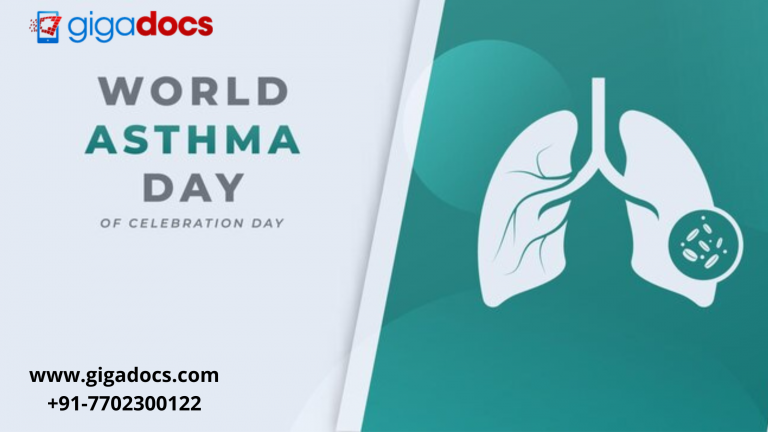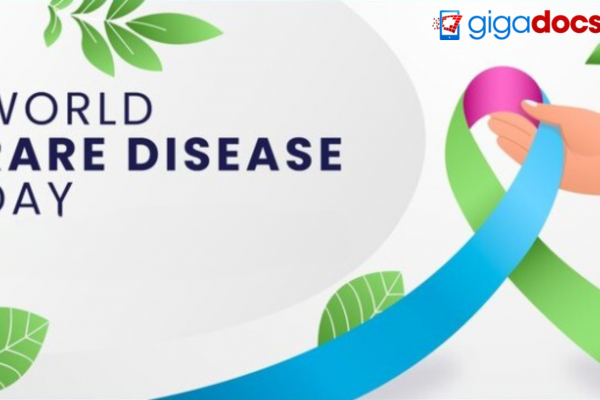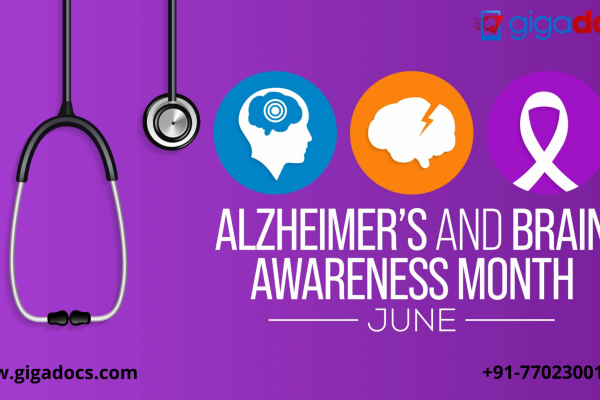Asthma is a chronic respiratory condition characterized by inflammation and narrowing of the airways, which leads to recurring episodes of wheezing, breathlessness, chest tightness, and coughing. It is a common condition that affects the lungs and can vary from mild to severe.
When a person with Asthma comes into contact with specific triggers, such as allergens (e.g., dust mites, pollen, pet dander), irritants (e.g., smoke, strong odors, air pollution), respiratory infections, exercise, or emotional stress, their airways become inflamed and constricted. On World Asthma Day 2023, this blog raises awareness about Asthma, a chronic respiratory condition affecting millions worldwide.
We discuss what Asthma is, what Asthma feels like, the causes of Asthma, the classifications of Asthma, types of Asthma, why Asthma is worse at night, treatment options available, and how teleconsultation can help with Asthma care-
What does an Asthma attack feel like?
An asthma attack, also known as an asthma exacerbation or flare-up, refers to a sudden worsening of asthma symptoms. During an asthma attack, the airways become severely inflamed and narrowed, making it difficult for air to flow in and out of the lungs. This can cause a range of distressing symptoms and can be a medical emergency if not treated promptly.
The symptoms experienced during an asthma attack can vary in intensity but often include the following:
- Severe shortness of breath: A person may face breathing difficulty and the inability to inhale enough air or fully exhale.
- Wheezing: A high-pitched whistling sound is heard during breathing due to the narrowed airways.
- Persistent coughing: It may be dry or accompanied by the production of thick, sticky mucus.
- Chest tightness: The chest may feel constricted or like someone is applying pressure.
- Rapid breathing: Breathing may become fast and shallow as the body tries to compensate for the limited airflow.
- Increased heart rate: The heart may beat faster than usual due to the body’s effort to obtain oxygen.
What Causes Asthma?
The exact causes of Asthma are not fully understood, but it may result from a combination of genetic and environmental factors. Here are some factors that contribute to Asthma’s development:
- Hereditary factors: Asthma tends to run in families, suggesting a genetic component. You may have a higher risk of developing Asthma if you have a family history of Asthma or allergies.
- Allergens: Allergens are substances that can trigger an allergic reaction in susceptible individuals. Common allergens associated with Asthma include dust mites, pollen, pet dander, mold spores, and certain foods. When inhaling these allergens, they can cause inflammation and narrowing of the airways.
- Respiratory infections: Certain respiratory infections, particularly during early childhood, are linked to an increased risk of Asthma. Viral infections, such as the common cold, can cause inflammation in the airways and trigger asthma symptoms.
- Occupational factors: Some individuals may develop Asthma due to exposure to certain substances in the workplace, such as chemicals, dust, or fumes. Occupational Asthma typically improves when the person is away from the workplace.
- Obesity: Obesity can exacerbate the risk of developing Asthma. The exact mechanisms behind this link are not fully understood, but inflammation and changes in lung function due to excess weight may contribute to asthma development.
- Environmental factors: Exposure to certain environmental factors and irritants can increase the likelihood of developing Asthma or trigger asthma symptoms. These include tobacco smoke, air pollution, chemical fumes, strong odors, and respiratory infections.
It’s important to note that while these factors increase the risk of Asthma, not everyone exposed to the abovementioned factors will develop the condition. Additionally, asthma triggers can vary from person to person, and what triggers symptoms in one individual may not affect another. Let’s understand how Asthma is classified-
How Is Asthma Classified?
Asthma is classified based on the severity and frequency of symptoms and the level of asthma control. The classification helps to guide treatment decisions and management strategies. The Global Initiative for Asthma (GINA) provides the most commonly used classification system. Here are the main categories:
| Asthma Classification | Frequency of Symptoms | Aggravating Factors | Treatment Options available |
| Moderate persistent asthma | Symptoms occur daily, and nighttime symptoms occur more than once a week. Lung function tests show airflow limitation. | Exacerbations may occur weekly and affect daily activities. | Treatment often includes daily controller medications in addition to quick-relief medications. |
| Severe persistent asthma | Symptoms are frequent, and nighttime symptoms occur often. Lung function tests show significant airflow limitation. | Exacerbations are frequent and severe, significantly affecting daily activities. | Intensive treatment with high-dose controller medications oral corticosteroids, and advanced therapies may be required. |
| Intermittent asthma | Symptoms occur less than twice a week, and nighttime symptoms are infrequent. | Exacerbations may affect activity but are brief and resolved spontaneously | Lung function tests (spirometry) |
| Mild persistent asthma | Symptoms occur more than twice a week but less than once daily. Nighttime symptoms occur more than twice a month. | Exacerbations may affect the activity and require short-acting bronchodilators frequently. | Lung function tests may show a slight decrease in airflow. |
It’s important to note that asthma classification is not static and can change over time. These classifications may be adjusted based on the individual’s response to treatment, symptoms, and lung function changes. Let’s understand the different types of Asthma in the section below-
Types of Asthma
- Allergic asthma- This is a specific subtype of asthma triggered by allergens. It is the most common form of asthma, accounting for a significant proportion of asthma cases. Allergic asthma occurs when an immune system overreacts to specific allergens, leading to airway inflammation and asthma symptoms.In allergic asthma, exposure to specific allergens can provoke an immune response characterized by releasing inflammatory substances called histamine. This immune response causes the airways to become inflamed, narrow, and produce excess mucus, leading to the characteristic symptoms of asthma.
Common allergens that can trigger allergic asthma include:
- Pollen: Pollen from trees, grasses, and weeds can be a potent trigger for allergic asthma, especially during certain seasons.
- Dust mites: These microscopic insects are commonly found in bedding, upholstery, and carpeting. Dust mite allergens can become airborne and trigger asthma symptoms.
- Pet dander: Allergens found in the skin flakes, urine, and saliva of animals, such as cats, dogs, and rodents, can trigger allergic asthma in susceptible individuals.
- Mold spores: Mold can grow in damp environments, and mold spores can become airborne, triggering asthma symptoms when inhaled.
- Cockroach allergens: Proteins found in the feces, saliva, and body parts of cockroaches can be a trigger for allergic asthma, particularly in urban areas.
- Non-allergic asthma- Non-allergic or non-atopic asthma is a subtype of asthma not triggered by specific allergens. Unlike allergic asthma, which is characterized by an immune response to allergens, non-allergic asthma is triggered by irritants, exercise, cold air, respiratory infections, or stress.
Here are some key points about non-allergic asthma:
- Triggers: Non-allergic asthma can be triggered by various factors, including:
- Irritants: Exposure to irritants such as smoke, strong odors, chemical fumes, air pollution, or dust can provoke asthma symptoms in non-allergic individuals.
- Exercise-induced: Physical activity, particularly vigorous exercise, can lead to asthma symptoms in some individuals. This is known as exercise-induced bronchoconstriction (EIB) or exercise-induced asthma (EIA).
- Cold air: Breathing in cold air can cause airway constriction and trigger asthma symptoms in non-allergic individuals.
- Respiratory infections: Viral infections, such as the common cold or flu, can lead to inflammation in the airways and trigger asthma symptoms.
- Stress: Emotional stress and anxiety can exacerbate asthma symptoms in some individuals.
- Diagnosis: Non-allergic asthma is diagnosed based on asthma symptoms and a positive response to bronchodilator medications, even without specific allergic triggers.
It’s important to note that some individuals may have a combination of allergic and non-allergic triggers for their asthma symptoms. The management approach may involve addressing allergic and non-allergic triggers in such cases.
Why do Asthma symptoms worsen at night?
Asthma symptoms can often be worse at night, and this phenomenon is known as nocturnal asthma. There are several reasons why asthma may be concerning during nighttime:
- Circadian Rhythm: Our body’s natural internal clock influences various physiological processes. For people with asthma, the airways may become more reactive and inflamed during nighttime due to the body’s natural circadian rhythm. This can lead to increased asthma symptoms and airflow limitation.
- Reclining Position: When lying down, especially in a flat position, gravity can affect airflow distribution in the lungs. In this position, there may be more pressure on the diaphragm, making it harder for air to move in and out of the lungs. Additionally, mucus may accumulate in the airways due to reduced clearance mechanisms, further contributing to breathing difficulties.
- Exposure to Allergens: Allergens, like dust mites, pet dander, or mold, can accumulate in bedding, pillows, and carpets. When you lie down at night, you may come into contact with these allergens, triggering asthma symptoms in susceptible individuals.
- Cooling of Airways: During the night, the air tends to be calmer and drier, which can cause the airways to become more sensitive and prone to constriction. Cold air can trigger bronchoconstriction and worsen asthma symptoms.
- Supine Gastroesophageal Reflux (GERD): Some people with asthma may also have gastroesophageal reflux disease (GERD), where stomach acid flows back into the esophagus. When lying down, this acid can reach the throat and airways, leading to irritation and exacerbation of asthma symptoms.
- Medication Timing: If your asthma medications, like long-acting bronchodilators or controller medications, are not appropriately taken or worn off during the night, it can contribute to aggravating symptoms.
It’s important to discuss your nighttime asthma symptoms with your healthcare professional. They can evaluate your situation, review your asthma management plan, and recommend appropriate adjustments to help improve your symptoms during the night. What to do during an Asthma attack? let’s find out:
First Aid to be followed during an Asthma Attack
During an asthma attack, it is important to take immediate action. The following steps are recommended:
- Use rescue medication: If you have a prescribed inhaler, use it as directed to help open the airways and relieve symptoms.
- Seek medical help: If your symptoms do not improve or worsen rapidly, it is vital to seek immediate medical assistance. Severe asthma attacks may require urgent medical intervention and monitoring.
- Stay calm and sit upright: Remaining calm and sitting upright can help alleviate some breathing difficulties. Book an immediate consultation with expert physicians on the Gigadocs app.
- Avoid triggers: If you are aware of any specific triggers that can worsen your asthma, try to remove yourself from that environment or exposure.
It’s worth noting that an asthma attack can vary in severity, and some individuals may have mild attacks that resolve quickly with proper treatment. In contrast, others may experience severe and prolonged attacks that require intensive medical intervention. Regular asthma management, including adherence to prescribed medications and avoidance of triggers, can help reduce the frequency and severity of asthma attacks.
When to see a doctor for Asthma
It is essential to see a doctor for asthma if you experience any of the following situations:
- Persistent or worsening symptoms: If you have ongoing or worsening asthma symptoms, such as wheezing, coughing, shortness of breath, or chest tightness, it is essential to seek medical attention. Uncontrolled symptoms can negatively impact your daily activities and quality of life.
- Frequent asthma attacks: If you are experiencing frequent asthma attacks or your symptoms interfere with your daily life, it is essential to consult a healthcare professional. Frequent or severe asthma attacks may indicate inadequate asthma control and the need to adjust your treatment plan.
- Need for quick-relief medication: If you rely heavily on quick-relief medication (rescue inhalers) to relieve symptoms, it suggests that your asthma is not well-controlled. Regular use of quick-relief medication indicates the need for further evaluation and adjustment of your asthma management.
- Nighttime symptoms: If your asthma symptoms, such as coughing, wheezing, or shortness of breath, are worse at night or disrupt your sleep, you should see a doctor. Nocturnal asthma can indicate poor asthma control and may require additional interventions.
- Difficulty performing usual activities: If your asthma symptoms make it challenging to participate in regular activities, such as exercise or physical exertion, it is essential to seek medical attention.
- Need for frequent or prolonged use of oral corticosteroids: If you require frequent or prolonged courses of oral corticosteroids to control your asthma, it indicates your asthma control needs a doctor’s consultation.
- Concerns or questions about your asthma management: If you have concerns, questions, or uncertainties about your asthma treatment plan, medication use, or any aspect of your condition, it is advisable to consult a doctor. They can provide guidance and education and address any specific concerns.
Teleconsultation for Asthma Treatment
Teleconsultation, also known as telemedicine or virtual visits, is a remote healthcare service that allows individuals to consult with healthcare professionals through video or audio calls, text messaging, or other digital platforms. Teleconsultation facilities with Gigadocs can be a valuable option for asthma individuals, especially in situations like-
- Routine follow-ups: Gigadocs teleconsultation can be a convenient option for routine follow-up visits, focusing on reviewing symptoms, assessing asthma control, and making necessary adjustments to the treatment plan. Suppose your asthma is well-controlled, and you do not have any urgent concerns or need a physical examination. In that case, you can always stay connected with your healthcare professional with Gigadocs.
- Medication management: Teleconsultation can be helpful for medication management, including prescription refills, reviewing inhaler techniques, and addressing any questions or concerns about medications. Your healthcare professional can assess your medication regimen and guide proper use and potential side effects.
- Asthma action plan review: Your healthcare professional can review and update your asthma action plan through a digital consultation. They can ensure that you clearly understand how to manage your asthma, recognize early signs of worsening symptoms, and know when to adjust medications based on the plan on a telephone call based on your convenient timings.
- Symptom assessment: Teleconsultation allows you to discuss your asthma symptoms with your healthcare professional, including any changes or concerns you may have. While a physical examination is impossible during a teleconsultation, detailed symptom history, and discussion can still provide valuable information to guide asthma management.
- Education and self-management: Gigadocs provide an opportunity for education on asthma self-management, including lifestyle modifications, trigger avoidance, and proper monitoring techniques. Your healthcare professional can provide personalized advice and answer any questions.
An in-person visit may be necessary in certain situations, especially when symptoms are severe. Ensure that you have a stable internet connection, a private and quiet space for the consultation, and any necessary devices to demonstrate inhaler techniques or peak flow measurement if required during a digital consultation.
To avail of digital consultation on Gigadocs, download the app from-
- IOS App – apple.co/2W2iG4V
- Android App – bit.ly/33AQoRC
To know more e-mail, at info@gigadocs.com




